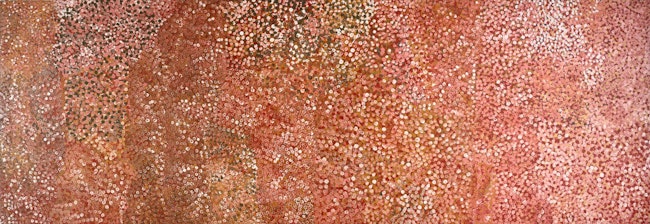The art that made me: Natasha Walsh
In The art that made me, artists discuss works in the Art Gallery of New South Wales collection that either inspire, influence or simply delight them.

Natasha Walsh with her nearly completed 2022 Archibald Prize entry, photo: Janie Barrett / The Sydney Morning Herald
Natasha Walsh with her nearly completed 2022 Archibald Prize entry, photo: Janie Barrett / The Sydney Morning Herald
Ways of seeing and being seen are at the heart of Natasha Walsh’s practice. The multi-time Archibald Prize finalist and winner of the 2018 Brett Whiteley Travelling Art Scholarship will be exploring representations of the female subject and dissecting historic notions of ‘the female muse’ in her work for The National 4: Australian Art Now. Walsh will work with leading Australian women artists, capturing their likenesses and at the same time reworking historic, canonical paintings by male artists. A room within the Brett Whiteley Studio will become a studio for Walsh throughout the exhibition, inviting visitors into the conversation. ‘As a female looking back, I, like many other female artists, have found it disconcerting to rarely see women represented as equal humans,’ Walsh says. Working with her sitters, Walsh intends ‘to give the muse agency’. Walsh’s work Hysteria will take place at Brett Whiteley Studio in Surry Hills from 24 March 2023.
Emily Kame Kngwarreye Untitled (Alhalker) 1992

Emily Kame Kngwarreye Untitled (Alhalker) 1992, Art Gallery of New South Wales © Estate of Emily Kame Kngwarreye / Copyright Agency
Kngwarreye gave me one of my earliest experiences with art by a First Nations artist. I remember being fascinated by the physical and metaphorical layering within her work. The marks had the rhythm of song and dance while also evoking a shifting desert in full bloom. I learnt while sitting on the cold Art Gallery floor that Kngwarreye incorporated her knowledge as an Elder into this work. The hidden layers of meaning seemed magical to me and fostered a deep appreciation for Australia’s rich cultural history, especially as the power of the feminine seemed to be on full display.
Nora Heysen Self-portrait 1932

Nora Heysen Self portrait 1932, Art Gallery of New South Wales © Lou Klepac
Nora Heysen Self portrait 1932, Art Gallery of New South Wales © Lou Klepac
Sometimes you encounter an artwork and unbeknownst to you it plants itself deep inside your psyche. It’s only in looking back, years later, that you can perceive its effect. Such was the case with Heysen’s self-portrait. As a teenager I appreciated the quiet strength of this figure who firmly presented herself as the master of her own representation, as she gazed back at me with curiosity. Heysen was 22 when she painted this which, curiously, mirrors the age I completed my first self-portrait in copper and my first time in the Archibald. Heysen herself remains the youngest artist to win the Archibald, at 28.
Tracey Emin I do not expect 2002

Tracey Emin I do not expect 2002, Art Gallery of New South Wales © Tracey Emin/DACS. Copyright Agency
Tracey Emin I do not expect 2002, Art Gallery of New South Wales © Tracey Emin/DACS. Copyright Agency
I remember having just hit puberty when I first saw Emin’s work and feeling a range of conflicting desires and drives, as though they were my own, in an unexpectedly direct voice. Sadness, wilful resilience, anger, frustration, a yearning to be seen and wanted, desire for love and for the perceived freedom of innocence. A confusing maelstrom of emotions that didn’t yet belong to me. That’s the key with Emin: you understand her work through feeling. She invites us to empathise with the experience of a single woman, as a means of accessing the experience of other women. Giving all of those disquieting unspoken emotions a voice by exposing her own deeply held vulnerabilities.
Brett Whiteley Self portrait in the studio 1976

Brett Whiteley Self portrait in the studio 1976, Art Gallery of New South Wales © Wendy Whiteley / Copyright Agency
Brett Whiteley Self portrait in the studio 1976, Art Gallery of New South Wales © Wendy Whiteley / Copyright Agency
Whiteley’s studio was the first artist studio I ever visited as a child. I remember feeling so completely at home there among such quirky, playful and unexpected pieces. It felt like the pure force of the imagination was manifested there into art. It was only as I became a teenager that I started to wonder at my place as a woman within that space. Is it really as just a faceless nude? To exist only in the hopes of being validated by the male gaze in his story?
A version of this article first appeared in Look – the Gallery’s members magazine